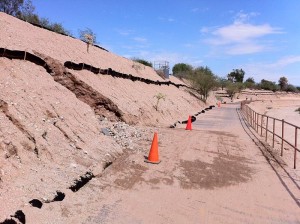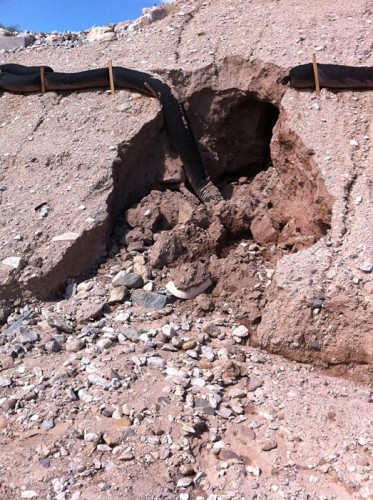
Several portions of the Loop have been severely affected by the recent rains.
John Spiker, an engineer with the Pima County Flood Control program, wrote in an email that the underpass that connects the Rillito and Santa Cruz river paths was flooded and closed.
He said the path could be closed for several weeks while they clean up the mess and complete repairs that were delayed because of the flooding.
A section of the Rillito path between Craycroft and Swan Roads cuts into the wash itself and was flooded on Sunday. Several people said they could not pass the section and had to turn around or find an alternative route.
Another section of the Rillito path between Country Club and Hacienda del Sol Roads had several areas that were washed out making it difficult to pass. This portion of the path had been left dirt for many years because of drainage issues. The county attempted to mitigate those issues with things like retaining walls, but they haven’t been 100 percent effective.
Are there other sections of the Loop that aren’t passable because of the rain?


Before the Rillito River path got completely paved, I enjoyed practicing my off-road skills. This was especially fun between Campbell and the Tucson Racquet Club.
I think if you ask some of the geo/water people at Pima County, you’ll find they think that very little consideration was given to drainage along the bike path.
Another thing that chaps my hide: Irrigation. See those spaghetti lines along the Rillito Path? Why?
We should be using native plants and passive water harvesting earthworks in our common space*. It’s time to stop spending public money on irrigating plants. Let Mother Nature take care of herself.
*If you want to see this concept in action, pedal over to Biketoberfest on October 1st. Details about this event in the TucsonVelo.com calendar.
You’re absolutely correct. We live in desert, after all. Xeriscaping should be the order of the day, and any irrigation should be done with either harvested water or grey water. We certainly shouldn’t be using water to support non-native plants. When my wife and I bought a house on the Northwest side, the lawn that previous owners had cultivated in the back was killed. We let nature and summer heat do the work.
Unfortunately, so many people in Tucson (and elsewhere in communities in drought or in arid climes) either don’t appreciate, care, or fully understand what a precious resource water is here.
Martha, I agree that native plants are preferred. However, even native plants need some additional water for the first year or 2 after they are transplanted. If they don’t get the extra water the investment in planting them is more likely to be wasted. I’ve lost more than one native plant because I didn’t water them and felt the pain of losing my money and time.